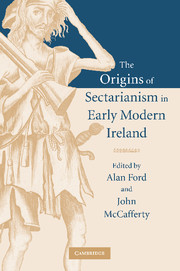Book contents
- Frontmatter
- Contents
- Preface
- List of contributors
- List of abbreviations
- 1 Living together, living apart: sectarianism in early modern Ireland
- 2 Confessionalisation in Ireland: periodisation and character, 1534–1649
- 3 Protestant prelates or godly pastors? The dilemma of the early Stuart episcopate
- 4 ‘In imitation of that holy patron of prelates the blessed St Charles’: episcopal activity in Ireland and the formation of a confessional identity, 1618–1653
- 5 A haven of popery: English Catholic migration to Ireland in the age of plantations
- 6 The Irish historical renaissance and the shaping of Protestant history
- 7 Religion, culture and the bardic elite in early modern Ireland
- 8 The political and religious thought of Florence Conry and Hugh McCaughwell
- 9 Sectarianism: division and dissent in Irish Catholicism
- 10 Purity of blood and purity of faith in early modern Ireland
- 11 Concluding reflection: confronting the violence of the Irish reformations
- Index
11 - Concluding reflection: confronting the violence of the Irish reformations
Published online by Cambridge University Press: 24 November 2009
- Frontmatter
- Contents
- Preface
- List of contributors
- List of abbreviations
- 1 Living together, living apart: sectarianism in early modern Ireland
- 2 Confessionalisation in Ireland: periodisation and character, 1534–1649
- 3 Protestant prelates or godly pastors? The dilemma of the early Stuart episcopate
- 4 ‘In imitation of that holy patron of prelates the blessed St Charles’: episcopal activity in Ireland and the formation of a confessional identity, 1618–1653
- 5 A haven of popery: English Catholic migration to Ireland in the age of plantations
- 6 The Irish historical renaissance and the shaping of Protestant history
- 7 Religion, culture and the bardic elite in early modern Ireland
- 8 The political and religious thought of Florence Conry and Hugh McCaughwell
- 9 Sectarianism: division and dissent in Irish Catholicism
- 10 Purity of blood and purity of faith in early modern Ireland
- 11 Concluding reflection: confronting the violence of the Irish reformations
- Index
Summary
There are plenty of reminders in this book of how gross and disfiguring were the confessional hatreds and acts of violence carried out in the name God in early modern Ireland. The rack dislocated the joints and the screw splintered the thumbs of Catholic priests and Catholic conspirators in Elizabethan and early Jacobean England (although the reign of terror lasted barely twenty-five years), and the boot splintered the shinbones of Covenanters in later Stuart Scotland (although the reign of terror was briefer still), but the intention was always to secure information that could lead to the capture of co-conspirators. And it was usually accompanied by that most chilling of all oxymorons – an instruction to the interrogators to use ‘the gentler tortures’ first – as in the case even of Guy Fawkes. One does not suspect that the efficient collection of information was foremost in the minds of those who tortured Dermot Hurley, archbishop of Cashel, as described by Alan Ford in the toe-curling opening to this volume (above). And in Ireland torture and gross humiliation for the sake of it, resulted both from confessional self-righteousness and a desire for revenge escalating over many decades, and, again as Ford points out, is still with us. Equally unfamiliar to historians of England would be the stories of the heads of enemies being posted off coarsely packaged, or corpses being dug up and roughly reinterred in unconsecrated ground (above, pp. 00–00).
- Type
- Chapter
- Information
- The Origins of Sectarianism in Early Modern Ireland , pp. 229 - 239Publisher: Cambridge University PressPrint publication year: 2005
- 1
- Cited by



